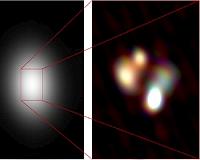| . |  |
. |
La Silla, Chile (SPX) Jun 09, 2010 A new robotic telescope has had first light at ESO's La Silla Observatory, in Chile. TRAPPIST (TRAnsiting Planets and PlanetesImals Small Telescope) is devoted to the study of planetary systems through two approaches: the detection and characterisation of planets located outside the Solar System (exoplanets) and the study of comets orbiting around the Sun. The 60-cm telescope is operated from a control room in Li�ge, Belgium, 12 000 km away. "The two themes of the TRAPPIST project are important parts of an emerging interdisciplinary field of research - astrobiology - that aims at studying the origin and distribution of life in the Universe," explains Micha�l Gillon, who is in charge of the exoplanet studies. "Terrestrial planets similar to our Earth are obvious targets for the search for life outside the Solar System, while comets are suspected to have played an important role in the appearance and development of life on our planet," adds his colleague Emmanu�l Jehin, who leads the cometary part of the project. TRAPPIST will detect and characterise exoplanets by making high precision measurements of "brightness dips" that might possibly be caused by exoplanet transits. During such a transit, the observed brightness of the star decreases slightly because the planet blocks a part of the starlight. The larger the planet, the more of the light is blocked and the more the brightness of the star will decrease [1]. "ESO's La Silla Observatory on the outskirts of the Atacama Desert is certainly one of the best astronomical sites in the world," says Gillon. "And because it is already home to two superb exoplanet hunters, we couldn't have found a better place to install our robotic telescope." The astronomers behind the TRAPPIST initiative will work very closely with the teams using HARPS on the 3.6-metre telescope and CORALIE attached to the Swiss 1.2-metre Leonhard Euler Telescope, both at La Silla. TRAPPIST is a collaboration between the University of Li�ge and the Geneva Observatory, Switzerland. The telescope is installed in the building that housed the old Swiss T70 telescope. Thanks to this collaboration, the whole project is on a fast track: it took only two years between taking the decision to build and first light. TRAPPIST will also be used for the study of southern comets. To this aim, the telescope is equipped with special large, high quality cometary filters, allowing astronomers to study regularly and in detail the ejection of several types of molecules by comets during their journey around the Sun. "With dozens of comets observed each year, this will provide us with a unique dataset, bringing important information about their nature," says Jehin. TRAPPIST is a lightweight 0.6-metre robotic telescope, fully automated and moving precisely across the sky at a high speed. The observing programme is prepared in advance and the telescope can perform a full night of observations unattended. A meteorological station monitors the weather continuously and decides to close the dome if necessary.
Share This Article With Planet Earth
Related Links La Silla Observatory Space Telescope News and Technology at Skynightly.com
 First High-Res Image From LOFAR Radio Telescope Array
First High-Res Image From LOFAR Radio Telescope ArrayBonn, Germany (SPX) Jun 02, 2010 The Max-Planck-Institut fuer Radioastronomie (Bonn) and the Max-Planck-Institut fuer Astrophysik (Garching), both run stations of the International LOFAR telescope (ILT), coordinated by ASTRON, the Netherlands Institute for Radio Astronomy. By connecting the German LOFAR stations with the central stations in the Netherlands, an international group of scientists led by Olaf Wucknitz from th ... read more |
|
| The content herein, unless otherwise known to be public domain, are Copyright 1995-2010 - SpaceDaily. AFP and UPI Wire Stories are copyright Agence France-Presse and United Press International. ESA Portal Reports are copyright European Space Agency. All NASA sourced material is public domain. Additional copyrights may apply in whole or part to other bona fide parties. Advertising does not imply endorsement,agreement or approval of any opinions, statements or information provided by SpaceDaily on any Web page published or hosted by SpaceDaily. Privacy Statement |